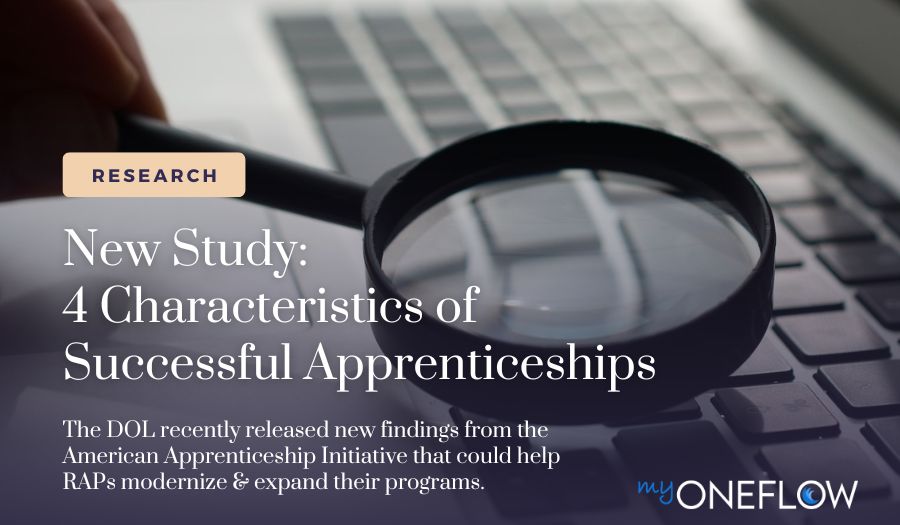Reimagining Apprenticeship: How Can We Actually Build a Future-Ready Workforce?
Apprenticeships have long been vital for workforce development, providing individuals with hands-on experience while addressing critical labor...
6 min read
 Emily Sleister
Jun 28, 2022 12:27:57 PM
Emily Sleister
Jun 28, 2022 12:27:57 PM

Since the pandemic, businesses have been facing an unprecedented labor shortage. As of June 2022, there were almost twice as many job openings as unemployed workers. And while 2021 saw the addition of 3.8 million jobs, over 4 million people quit their jobs every month during the first four months of 2022.
That’s almost 3% of the workforce.
Experts agree that the “Great Resignation” has a variety of causes but a few central themes. According to a recent Pew Research Center survey, “low pay, a lack of opportunities for advancement and feeling disrespected at work are the top reasons why Americans quit their jobs last year.” While most of these employees aren’t exiting the workforce entirely, that level of turnover is still a costly headache for businesses desperate to maintain a skilled labor force.
In today’s tight labor market, the job seeker has power. It’s up to employers to generate attractive opportunities that draw in and retain top talent. With so many jobs available, employees may quit and move laterally within their industry if they think a different employer can meet their needs better. The same Pew survey found that most people who left a job in 2021 and found new employment consider their new job to be an improvement.
One solution? Create your own highly trained pipeline of skilled talent by investing in an apprenticeship program for your business. The current labor force may seem slim, but in the last ten years, there has been a 64% growth in new apprentices. And job seekers seem interested in career shifts; in 2021, over half of the people who quit their current job for a new job also changed their field of work. Companies that offer apprenticeships are more likely to attract and retain this type of individual since apprenticeships can afford job seekers paid career development as they pursue better opportunities for themselves and their families.
Apprenticeships have long been vital for workforce development, providing individuals with hands-on experience while addressing critical labor...

.jpg)
Apprenticeships provide an excellent opportunity for employers and job seekers to build long-term, mutually beneficial relationships. By combining...
Apprenticeships have long been a way for unskilled workers to learn a trade by working closely with seasoned professionals. In 1937, President Roosevelt signed the National Apprenticeship Act (NAA), creating a federally recognized Registered Apprenticeship Program (RAP) regulated by the Department of Labor (DOL). The goal was twofold: to promote the growth of a highly skilled labor force and to protect apprentices from unsafe working conditions and discrimination.
Apprenticeships still serve as a foundation for workforce development in the United States, and the system is constantly expanding. Apprenticeship programs now exist in industries outside of trade skills, including technology, advanced manufacturing, healthcare, and more. All Registered Apprenticeship Programs include the following five components:
This model offers unique benefits for both apprentices and employers. Traditionally, individuals who want to switch careers or learn a new job skill must enroll in a course or certification program. This decision often means tuition expenses, student loans, and lost wages if the individual can’t work while attending school. Apprenticeship programs’ “earn while you learn” model makes career development more accessible and equitable by combining classroom education with paid, on-the-job learning.
Sponsoring an apprenticeship program can provide your company with a myriad of benefits, including:
Typically, RAPs are a collaborative effort between employers and “intermediaries,” often local workforce development organizations and educational institutions. Apprenticeship management software, like myOneFlow, makes it easy to partner with intermediaries as you develop your apprenticeship program.
Features like document management, time tracking, and integrated analytics tools help your team stay organized and connected within your apprenticeship network. Plus, myOneFlow tracks all metrics and activities, so sharing required data with intermediaries is easy and secure.
Ongoing recruitment and hiring are costly and labor-intensive processes for any business. And considering that one survey found that 33% of new hires quit after 90 days, recruitment efforts can feel like a never-ending waste of money. An apprenticeship program allows you to access additional candidate pools through your intermediary. Staff at community colleges and workforce development offices can connect their clients with your apprenticeship program, so your team doesn’t have to carry the burden of recruitment efforts alone.
To guarantee successful collaboration and recruitment, stay connected with your apprentices and community partners through a dedicated platform like myOneFlow. Virtual labor exchange features make it easy to post your open positions, host or participate in virtual job fairs, and schedule interviews. Plus, myOneFlow uses the Microsoft stack to integrate your pre-existing Microsoft Teams and calendar applications seamlessly.
No matter how successful your recruitment process is, you need retention to match it if you're going to build a strong team. While retention is notoriously challenging for employers, 94% of apprentices retain employment with the sponsoring company after completing their apprenticeships. Employers who invest in apprenticeship programs are creating a pipeline of skilled, committed workers who have already received years of training and mentorship specific to their company.
myOneFlow’s powerful analytics also help employers and apprenticeship program directors identify specific areas of improvement within their programs. For example, pipeline reports can display apprentice metrics throughout the program's life, making it easy to see how many apprentices are either prematurely exiting the program or leaving the company after its completion. Analyzing these metrics can help you and your team fine-tune your apprenticeship program for better retention and apprentice outcomes.
Apprenticeship programs are not only successful in theory; employers see an average ROI of 28% from their programs. Even more impressive, the benefits appear to be cumulative; every $1 spent on apprenticeship programs yields roughly $28 in public benefits. Thanks to their many measurable benefits, there are a wide variety of state and federal funding opportunities and tax breaks designed to incentivize the creation and expansion of apprenticeship programs.
The Workforce Innovation and Opportunity Act (WIOA) provides millions of dollars of grant money to help stimulate the workforce by providing high-quality training and career opportunities to individuals with significant barriers to employment. Depending on eligibility, employers can use WIOA funding to offset various apprenticeship training costs. They may even qualify for reimbursement of up to 75% of paid apprentice wages for up to six months. The Federal Resources Playbook for Registered Apprenticeship is an excellent resource that details the various types of federal funding available for apprenticeship programs.
When you hire an employee who has only received general training and has job experience at another company, it takes time and energy to retrain them to your company’s specific ways of doing things. For employees steeped in their old habits, it can feel like trying to fit a round peg in a square hole, even after years of employment. On the other hand, apprentices undergo years of highly specialized training throughout their apprenticeship, giving them an intimate knowledge of your company’s specific workflows. There's no need to hire solely on resumes and interviews alone. If you offer an apprentice an official position after program completion, it will be because you're confident they'll be an excellent fit for your team.
As your apprentices turn into full-time employees, this model can help your company standardize processes and boost productivity. Plus, the effect is cumulative and cyclical; great apprentices make great employees who, in turn, make great team leaders and trainers for your next round of apprentices.
While apprenticeships offer many benefits for individuals, companies, and the workforce, they come with a lot of moving parts and collaborating entities. Successful and sustainable apprenticeship programs rely on a solid organizational framework connecting apprentices, employers, and intermediaries.
myOneFlow’s intuitive platform seamlessly links all the pieces of the apprenticeship puzzle. Case management tools allow teams to easily track and manage apprentices, share documents and information, and send communications and referrals. It also features highly configurable workflow automation capabilities that simplify the apprentice’s journey and help keep them on track to program completion.
For decades, we’ve connected teams in social services, adult education, consortiums, government organizations, and more. Whether you've run a successful apprenticeship program for years or are still in the beginning stages of conceptualization, myOneFlow brings you the tools and configurability to help your program excel. Contact our team today to schedule a demo and learn more about how myOneFlow can support your organization.
Apprenticeships have long been vital for workforce development, providing individuals with hands-on experience while addressing critical labor...

.jpg)
Apprenticeships provide an excellent opportunity for employers and job seekers to build long-term, mutually beneficial relationships. By combining...